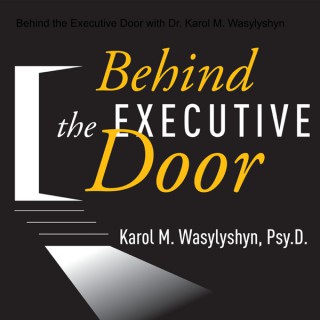Behind the Executive Door with Dr. Karol M. Wasylyshyn
Follow Behind the Executive Door with Dr. Karol M. WasylyshynBehind the Executive Door presents an inside look, an opening, an oasis of guidance intended to help early career people become more successful sooner. This information, distilled from the executive coaching case files of hundreds of CEOs and other top bu
- Sep 28, 2021 LATEST EPISODE
- infrequent NEW EPISODES
- 10m AVG DURATION
- 13 EPISODES
Latest episodes from Behind the Executive Door with Dr. Karol M. Wasylyshyn

How to Use an Executive Coach to Become Even More Effective Than You Already Are
Executive coaching has become a super popular resource for the further development of talented employees. Since there are literally thousands of “coaches” out there, here are key factors for choosing a qualified one and for using that coach effectively.

Giving people candid and timely performance feedback continues to be a challenging issue in the workplace—even for top business leaders. Here's a model for having these conversations in a way that is both truthful and constructive.

While the concept of emotional intelligence has been popularized in businesses throughout the world, people are not always clear on exactly what it means. Here's what it is, its four dimensions, and a tool for using it at work.

Organizations value people who get-things-done. And if this is one of your strengths, you must value yourself for it. However, your doing could be a limiting factor if you aspire to bigger roles. Learn about this—and consider how you may need to re-brand yourself lest you get locked into a career plateau.

Many people wind up in their jobs more by accident than plan. If you're in this trap—and especially if you have another work-related aspiration—here's an approach to get you started on changing your career path.

Making bad hires is a common issue among top business leaders and at all organization levels. Learn the key reason this happens—and how you can help this not happen in your company.

Research from social psychology reveals important clues about what goes on in the first 64 seconds of a job interview. Here are factors that will help you nail those first seconds—and then how to leverage a positive first impression.

What does it take to be seen as a “high potential” person in the minds of top business leaders? Five inter-related factors are described to help you accomplish just that.

Standing on Marbles: Using Metaphorical Thought to Illustrate Patterns of Boss Behavior
What do good, bad and ugly bosses look like? How do bosses representing each of these three patterns of behavior compare on criteria like leadership competencies (e.g. strategic thinking, managing people, driving results, executive credibility)? How emotionally intelligent are they? In this admittedly out-of-the-box podcast—poems are used to illustrate these boss patterns of behavior (and cliff notes are provided regarding the subject of each poem).

These bosses can be quite intelligent and even charming, however, they're also mean-spirited, manipulative, and often psychologically disturbed. Here's guidance for seeing them clearly for what they are, for getting through the short-term with them, and for tee-ing up your way out.

You don't have to just tolerate working for a bad boss. Here's guidance about how to deal with one effectively—guidance that can help minimize the frustration and anxiety these bad bosses can cause for the people reporting to them.

It's one thing to have a good boss—but it's another thing to get the most from that work experience. Here's some specific guidance about how to do just that and, to consider how doing this might have important implications for the way you are managing your career.

Listen to this podcast trailer for Behind the Executive Door! Based on three decades of coaching CEOs and other top business leaders, Dr. Karol M. Wasylyshyn provides quick lessons or insights that could help you advance your career success sooner.








